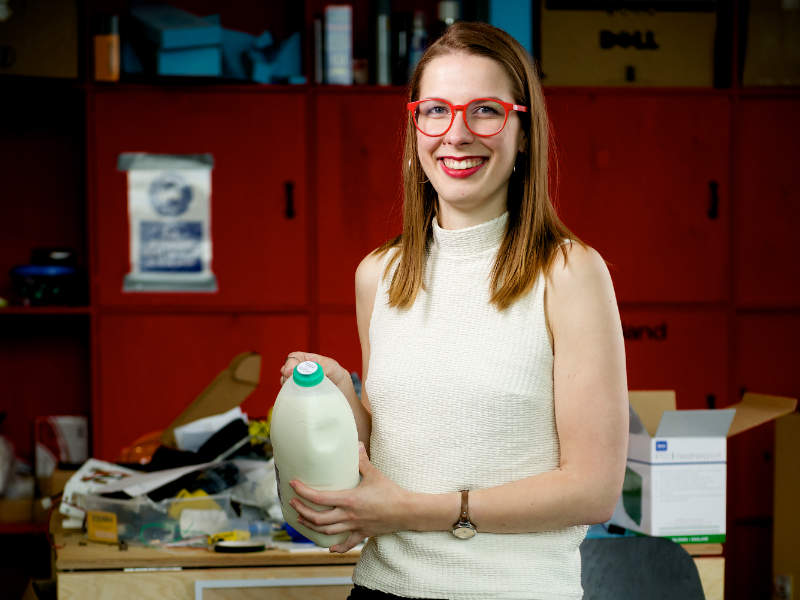
Use-by, sell-by and best-before dates on food and drink packaging lead to a monumental amount of waste, with consumers and retailers sticking dutifully to the dates listed on the front of the pack and throwing the food away without a second thought. Waste charity Waste & Resource Action Programme (Wrap) says that in the UK, a third of the country’s annual two million tonnes of food waste is entirely down to date-label confusion.
Towards the end of 2017, the UK government supported a Wrap initiative to redefine standards surrounding use-by date labelling, but wastage problems are unlikely to disappear without innovation in the labelling space.
Mimica Touch is the first product from Mimica, and the brainchild of founder and director Solveiga Pakštaitė. Winning ‘Gold’ at the inaugural Food Talk Awards last year, the product is expected to be on retail shelves soon, and promises ‘biologically accurate’ food spoilage information, with the label changing texture from smooth to bumpy once the food inside the package has expired. Pakštaitė provides more information about the Mimica Touch label, and how the process works.
Elliot Gardner: Where did the idea for the Mimica Touch come from?
Solveiga Pakštaitė: My background is in industrial design and I had the idea for Mimica Touch during my final year at Brunel University. I’m really interested in human-centred design and did a placement year at a human practice consultancy. While I was there I did a six-month project for the Guide Dogs for the Blind Association. I became really interested in how visually impaired people carry out daily tasks, and one of the questions I asked was ‘how do you know when your food goes off?’ That’s when I realised that visually impaired people can’t just use the date system like everyone else does.
From there I looked further into date labels, and came across the issue of food waste and the direct link between that and labelling. I realised we’re all blind to the problem of food expiry.
I wanted to create something that would add value to fully sighted people as well, and had the idea of a new kind of food label. I was inspired by a banana skin, which turns bumpy and brown as it gets older, so I imagined a piece of packaging that would do the same, where its texture would change as the product goes bad.
That’s where the concept for the Mimica Touch label came from. The label turns from smooth to bumpy within one hour after the food inside the package spoils.
EG: Do you always want to maintain that human-centred approach going forward?
SP: I hope so; I think that one of our differentiators from other companies trying to do a similar thing out there is that we are the most inclusive in terms of how you access the information. We want to develop an indicator that changes visually as well as in terms of texture, but at the moment we certainly have no plans to drop the tactile element of the label.
EG: One hour after the food spoils seems incredibly accurate – can you tell me more about how the technology works?
SP: The material in our indicator is actually a waste foodstuff itself. We’re using gelatine in the first version of the product, which is a waste by-product from the meat industry.
Because this is a high-protein gel, it actually denatures in the same way as other proteins, which is the process of protein decay. This is why we’re focusing on protein foods for the Mimica Touch first of all.
We can actually adapt the formulation of the gel to have the same spoilage profile as the food that we’re copying, hence the name ‘Mimica’. Each specific food product would have its own formulation tailored to it, using information that we would receive from food manufacturers. All manufacturers have done shelf-life tasting, so this data already exists.
We’re going to be launching initially on milk products, followed by yoghurt. We have a trial coming up after that for cooked sliced ham, and will likely be looking into ready meals after that.
EG: Is the label easy to mass produce?
SP: We’re actually looking at mass production right now. We’ve got a proof of concept in the lab, but now we’re looking at how to make millions of them!
We’ve designed the label in a way that we can make use of existing packaging machinery, so we don’t have to develop any machinery specific to the label. It’s essentially a sachet design, similar to a ketchup or vinegar sachet, but we’re adding an adhesive back to attach to the product packaging.
In terms of scaling up, it’s incredibly useful to make use of technology that is already there and in use.
EG: Is this the future of labelling for expiry dates?
SP: Absolutely – I’m a big advocate for not redesigning something when there isn’t a need to, but in the UK 60% of the food we throw away is still perfectly edible, so I don’t think the current system is serving us well at all.
My opinion is that the best solution is to use existing waste by-products, turning them into useful information, which is what we’ve done. More generally, I think biologically accurate food spoilage information is going to be the next generation of how we look at expiry, and that the status quo right now is simply not good enough. I see Mimica as the new standard of food labelling.



